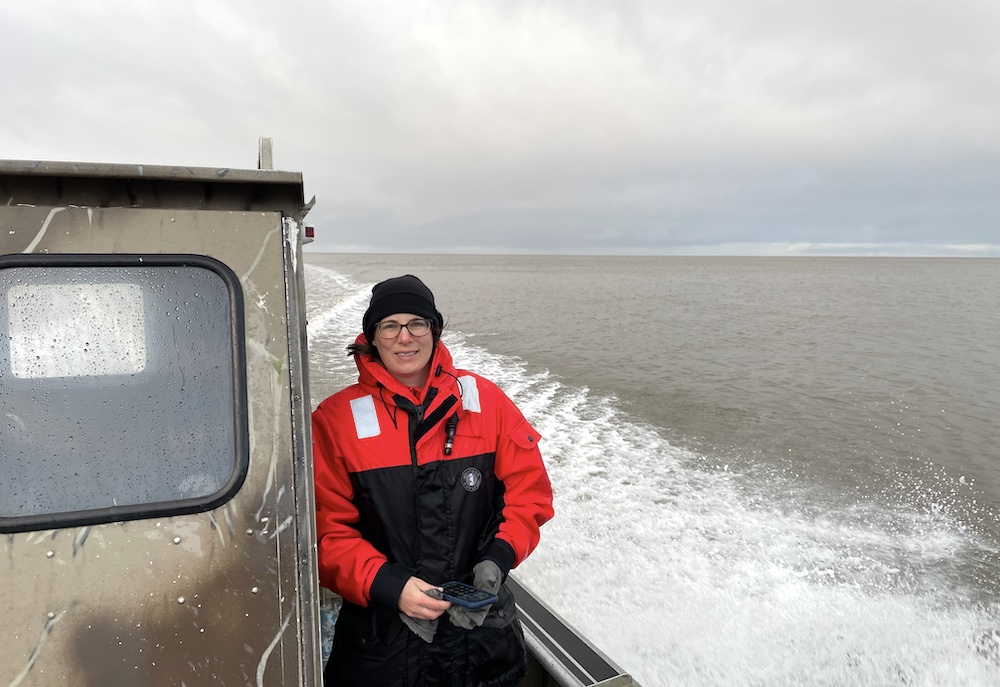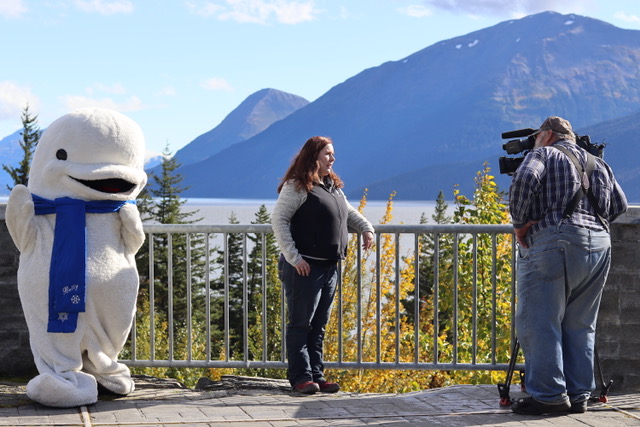
Taylor/Blakeslee fellow takes on field reporting in Alaska
Saima Sidik reporting from Alaska on a fishing boat repurposed as a cyanobacteria research vessel. Photo: Ajit Subramaniam
My visit to Kotzebue, Alaska came on the heels of a less welcome guest: Typhoon Merbok. As this powerful storm pummeled the west coast of Alaska, I enjoyed a sunny weekend in Anchorage, during which I frequently checked the Alaska Airlines website to see if my flight, like so many others, had been cancelled.
As luck would have it, mine was the first commercial flight to get into Kotzebue after the storm — and so it was packed. Kotzebue is a town of around 3,000 people, and the tiny airport was not built to accommodate the hundred-or-so-odd passengers that poured in all at once.
The chaos in the baggage claim area mirrored how I’d felt while preparing for my first professional reporting trip, which I was taking thanks to the Council for the Advancement of Science Writing’s Taylor/Blakeslee Mentored Project Fellowship. With the help of my mentor, PNAS Front Matter’s Amy McDermott, I’d gotten two stories accepted before the trip, and I was turning a third story over in my head, hoping to pitch it when I got home. Now, with all three published, I can sit back and enjoy the feeling of satisfying completion that comes with seeing one’s byline. But on that day in the airport, that feeling was still just an aspiration.

I’d spent the previous weekend in Anchorage, attending the city’s annual beluga count as part of my reporting for an article that would be published in Undark. Pitching this story had been tough because I’d wanted to find a new spin on how humans are harming wildlife. After a lot of reading, I was able to do this by focusing on how anthropogenic stresses intersect with whale culture. In Anchorage, I’d spent a day watching NOAA scientists and the city’s beluga recovery mascot, Betty, as they garnered public support for the whales. In Kotzebue, I was planning to interview Alaska Natives about traditional beluga hunting practices, and I was somewhat nervous about this. Some people want Alaska Natives to stop (or greatly limit) beluga hunting to protect the whales that visit the Kotzebue area. But if Indigenous people lose the practice, they’ll lose knowledge that’s been key to their survival and central to their culture. Nobody is happy about the situation, and I hope I’ve covered it sensitively and fairly.
My main mission in Kotzebue, however, was to report on cyanobacteria blooms for Hakai Magazine. These blooms have become increasingly noticeable in the local waters, possibly spreading the toxins they produce through water and wildlife. Fortunately for Kotzebue, nobody has yet been poisoned by these microbes. Unfortunately for me, that meant it was hard to find local sources to speak about the issue. I decided to write parts of this piece in the first person so that I could use my own experiences to give the article a sense of place, and a very gracious boat captain and local scientist filled in the rest.
After I got home, I also pitched an article to Grist about how erosion is swiftly sending Alaska into the sea. The big issue here was again finding an angle that hadn’t already been covered. Alaska’s erosion problem put climate change on display for me so clearly that I really wanted to highlight the issue, but a lot of journalists had already described the extent of the problem. Fortunately, I found a review article about possible solutions that pointed me in the right direction.
I trained as a science journalist during the height of the pandemic, when travel was not an option, so the opportunity to get out in the field to report these articles has filled in a part of my education that I missed out on. Amy, my mentor, was a fantastic resource when it came to figuring out how to overcome the challenges I’ve described in this blog post, and she’s become a great friend, as well. Thanks for helping me get started as a journalist, CASW! Keep doing great work.
Taylor Blakeslee Project Fellowships are funded by the Chicago-based Brinson Foundation, which also underwrites Taylor/Blakeslee Graduate Fellowships.